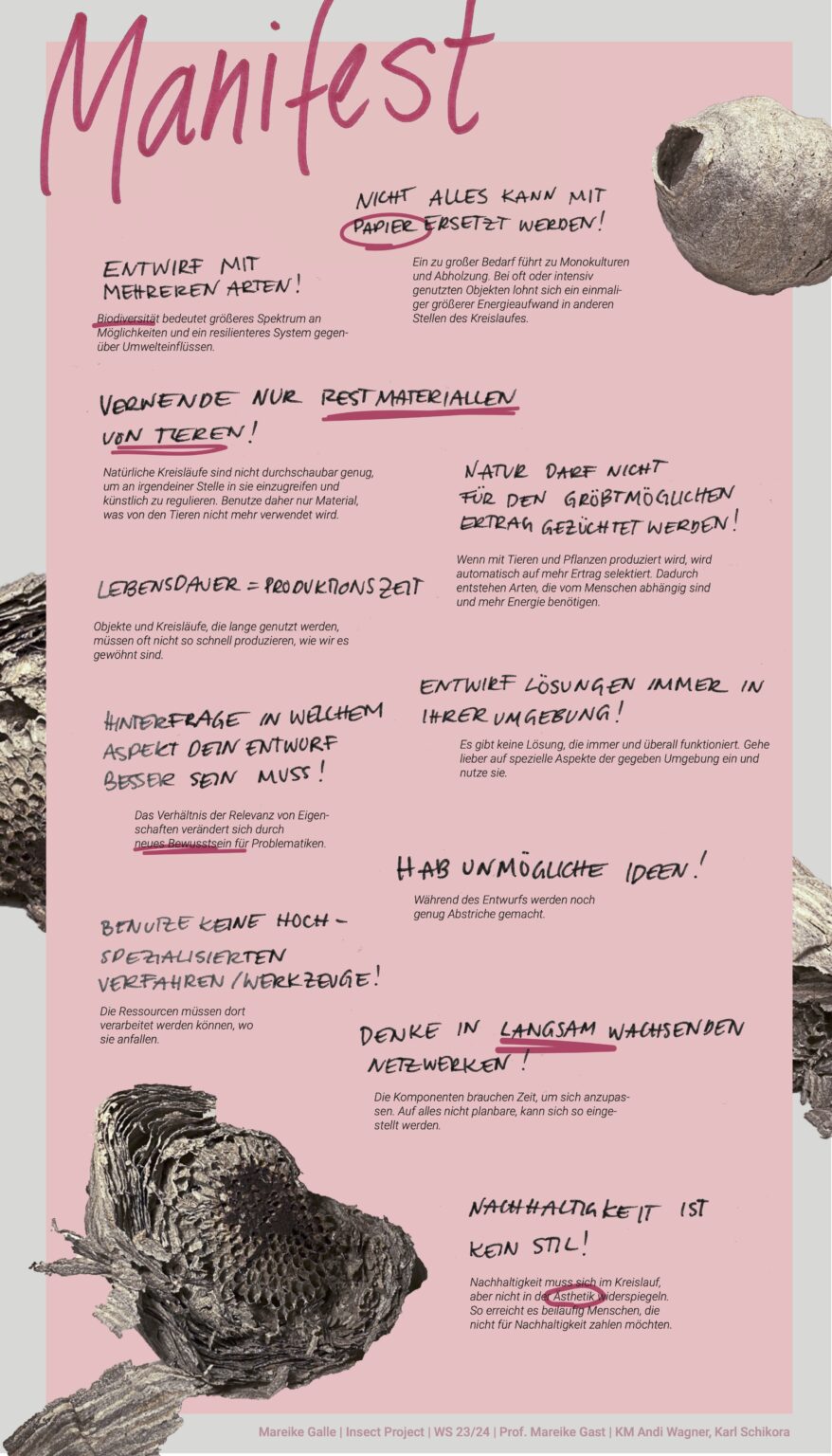Vespaper
sprayable wallpaper made from abandoned wasp nests
Paper is often perceived as an environmentally friendly material, but usually requires monocultures and a high consumption of energy and chemicals. For Vespapier, wasps manage forests in a system-sensitive way or utilise waste wood as an alternative source of cellulose. Every year, wasps build new nests by collecting and shredding plant cellulose – consuming significantly less energy and no chemicals in the process. Coloured nests are even created when the fibres are dyed. Vespapier collects the abandoned nests and shreds them. A spraying process turns the moistened fibres into a lively-looking wallpaper, with water-repellent properties imparted by the wasps.
| student: | Mareike Galle |
| project: | The Insect Project – Resilience Part I |
| year: | 2023/24 |
In the production of Vespaper, the wasps are provided with waste wood and paper. At the end of autumn, their abandoned nests are harvested and shredded. The concept shows three ways of cultivating wasps: First, as a wasp forest, in which a suitable number of wasp colonies live and produce a nest every year. Different species can be combined here as long as the ecosystem can tolerate it.
Second, living freely in industrial sites. Many wasp species are not aggressive. In production sites such as industrial estates that specialize in metal production, they can build their nests under the roofs. Automated production facilities help them to have even less contact with humans. Only when the nests are abandoned are they harvested. It should be noted that wasps also collect cellulose and prey several kilometres away. Farms with dried wood will have problems with wasps in the immediate vicinity.
Third, if the wasps are kept in wasp farms, the colour of their nests can be controlled. The farms consist of isolated areas, from which the insects cannot get in or out. In addition to food, they are provided with colour-sorted waste paper and wood. Each colony has access to one colour so that their nests are as uniformly coloured as possible. The native species do not need heat or controlled daily cycles.
The collected nests are dry and mechanically shredded until cellulose flakes are produced from them. This step requires significantly less energy and waste water than shredding and boiling wood. Standard machines are used for shredding, which can also be used for the production of waste paper fibres in paper recycling yards. The dry fibres are stored and transported in sacks. The wallpaper is applied with compressed air by trained but non-specialised craftsmen. The machines can be carried by one or two people. It is recycled as an addition to new Vespaper or added to the waste paper together with the non-recyclable core of the nest.
To spray using the CSO method, compressed air is connected to a container and mixed with the cellulose fibres. When sprayed out, they are moistened with water and stick to the wall. The method originates from building insulation with cellulose fibres, which are made from waste paper. In comparison, much finer nozzles are required for Vespaper. Spraying creates a lot of dust and takes about a day to dry. Whilst the wallpaper is still wet, it is pressed down with a pattern roller. It is not bleached or subsequently coloured. The intense colours, despite being produced by animals, come from sorted waste paper or wood. The mixing of the cellulose in the wasps’ mouths always gives it a slight grey tinge. It is therefore not possible to produce a pure white colour, but this is not the aim either. As no glue or other substances are added, the Vespaper can later be removed from the walls and shredded again. To do this, it must be thoroughly soaked. It is recycled as an addition to new Vespaper or added to the waste paper together with the non-recyclable core of the nest.
Vespaper should not replace all paper, because too many wasps will overwhelm any ecosystem, especially when kept in forests. There is another way of producing paper to avoid monocultures that threaten insect species in particular.

